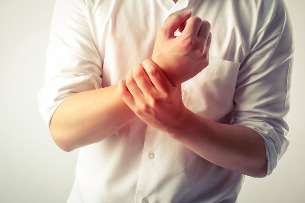The osteochondrosis is a disease, which is one of the most common in the world. Most people after the age of 35 years have the osteochondrosis of the cervical spine in one way or another. Lately there is a trend to increase the number of affected severe form of the disease and for the rejuvenation of the disease, reducing your lower the minimum age. This is because a growing number of people around the world takes care of the site work and maintain a sedentary lifestyle. Meanwhile, a disease that is quite dangerous, and any person should know what is the osteochondrosis, as is manifest and as it is, to be able to recognize their symptoms and timely treatment is initiated.

The causes of the degenerative disc disease cervical
The osteochondrosis is one of the few diseases that are characterized only to the human. In other animals, this disease does not occur. The reason for this, is the distinctive feature of the person, such as bipedalism. The vertical location of the spinal column causes pressure on the vertebrae between themselves and osteo-cartilage the cloth of the spine gradually degrades and deforms. The spine of the person begins with the cervical region. In total, the department of seven vertebrae, from the first to the seventh. The vertebrae are separated by intervertebral discs. The cervical spine is especially vulnerable, for their part, that should, in the first place, with an increase of the mobility of the vertebrae in this area. In the cervical region of the disease is reflected, above all, in the discs, which are a weak point in the structure of the spine. The prevalence of degenerative disc disease, cervical also contribute to factors such as the small size of the vertebrae and the relative weakness of the muscles of the neck. Also in the development of the degenerative disc disease cervical to be influenced by lack of blood supply in the cartilage tissue. Therefore, the development of the disease is a long and complex process and does not have a single cause. Although the link between the work of a man sitting at the table, and the presence of he the osteochondrosis cervical, however, the most prevalent disease and trained people, especially of the athletes of the increased load on the cervical spine when lifting weights. In older people, as a general rule, the degradation of the vertebrates of the structures is unavoidable process associated with aging of the body and the weakening of their defenses. However, it is more common type of degenerative disease of the cervical disc, in which the main role is played by internal or external negative factors.
Factors that favor the development of the degenerative disc disease in the neck:
- The violation of posture
- The curvature of the spine
- A back injury
- The excess weight
- Heavy work a physical
- Sedentary work
- The sedentary lifestyle
- The violation of the processes of change
- Frequent hypothermia
- Uncomfortable posture during sleep
- The stress, the exhaustion
- Hereditary factors
- Infectious diseases
- The characteristics of the structure of the body, for example, is too long or too short neck
Degree of development of the degenerative disc disease cervical
The disease has four stages. It's not always easy to determine the stage of the disease based on the analysis of the symptoms, as sometimes the degree of degradation of the osteo-cartilaginous tissue may not coincide with the symptoms observed in the patient.

The first degree of the
Begin the destructive processes in the osteo-cartilaginous tissue of the vertebrae. As a general rule, in this phase of the degenerative disc disease cervical symptoms are mild. Sick or not noticed or do not relate to the diseases of the spine, and is attributed to stress and fatigue.
The second degree of
Begins the decrease of the disc height, on its surface appear cracks. The symptoms of the degenerative disease of the cervical disc at this stage is manifested in constant pain, weakness, numbness of the individual parcels of the person.
Third grade
Form of the herniated disc, damaged neck vessels and muscles. The patient appear dizziness, pain in the occipital part of the head.
The fourth level
Appear osteophytes – bone expansion, which protect the vertebrae of the load, which leads to loss of the nerves. This leads to stiffness and damage to the neighbors of the joints.
The osteochondrosis of cervical: the symptoms
The main symptoms of the degenerative disc disease of cervical spine:
- Pain in the neck and shoulders
- The weakness of the muscles
- Increased sweating
- Numbness in the hands
- Lack of coordination
- Vertigo
- The deterioration of eyesight and hearing
- Increase in blood pressure
- Headaches
These are typical for degenerative disc disease cervical spine, the symptoms may be present at all stages of the disease. In most of the cases it is observed that some of the symptoms of the list, and the rest may be missing in the Man, for the first time are faced with these signs of illness, do not always suspect the same neck of the osteochondrosis. Therefore, you can access different physicians and therapists, cardiologists, neurologists, surgeons. And a correct diagnosis on the outcome can be delivered with a significant delay.

Syndromes
The osteochondrosis of cervical, there are some syndromes, that is to say, the typical diseases that have a complex of characteristic features. Manifest themselves in the function of the nerves and arteries are affected by the disease:
- the syndrome of the vertebral artery
- heart syndrome
- hypertensive syndrome
- radicular syndrome
- the cervical syndrome of migraine headaches
The syndrome of the vertebral artery is one of the most unpleasant and dangerous complications of osteochondrosis cervical. Him by the fact that it reduces blood flow of the artery, and extends along the spinal column and the power of the brain. The syndrome is manifested in such symptoms, as a system or periodic vertigo, weakening of hearing and vision. In some cases, may cause fainting. We often see a variant of the syndrome, the wraps in the fact that in the normal state of the blood in the normal artery, however when you turn the head on one side or the other can fall dramatically. Cardiac syndrome develops when squeezing the roots of the nerves responsible for the innervation of opening or muscle of the chest. In consequence, the patient may experience pain, reminiscent of the cardialgia, despite the direct effects on the heart are not. However, the syndrome can be characterized by phenomena such as tachycardia, hypotension and arrhythmias. The hypertension syndrome are also found here among the most dangerous complications. Unlike the syndrome of the vertebral artery, it is called compression, not from the arteries and veins, which hinders the reflux of blood from the head. The syndrome causes an increase in intracranial pressure that may manifest itself in such symptoms as nausea, vomiting, headache. The cervical syndrome of migraine has little to do in their etiology with the classic migraine. It is manifested in severe pain in the occipital part of the head. The pain is paroxysmal nature, they last up to ten hours, and accompanied by vomiting. Radicular syndrome most common syndrome of osteochondrosis of cervical. It's called compression of individual nerve roots cervical vertebrae. It can result in pains in the neck, the nape of the neck, the blades, the shoulders, numbness and weakening of the tone of the individual parcels of the hands (up to the impossibility of performing some type of manipulation) and the neck. Very often you can observe several of the symptoms or individual symptoms, specific for the different syndromes. As can be seen, the osteochondrosis of the cervical spine, the manifestations of the disease are and that it is not always the patient is able to properly recognize him for the cause. If you have similar symptoms, then it is a reason to call a doctor.

The diagnosis
For the installation of a diagnosis, it is recommended to consult a doctor. You will be given the address to an orthopedic specialist, spine, nevrologu. For the diagnosis we will apply the following types of research:
- The x-ray
- Computed tomography
- Magnetic, computed tomography
- The ultrasound scan of the neck vessels
The x-ray allows one to determine the displacement of the vertebrae, the presence of growths – osteophytes and salt sediments, the labels of disks. Ct scan consists of creating a series of x-ray images give the surround view of the authority, in this case on the cervical spine. Allows for specifying the pathological grade of a process of the nature of the oppression of the nerves, the structure of the osteophytes, the height of the discs, etc., magnetic Resonance imaging, computed tomography based on the effect of nuclear magnetic resonance, gives even more detailed structural insight of the spine. Ultrasound of the neck vessels helps to identify the changes in blood flow in the trunk vessels of the neck, is caused by the disease.
The treatment of degenerative disease of the cervical disc at home
How to cure osteochondrosis cervical in the home and it is if he at all? For the control of the disease, the medicine has developed many methods. Some of the forms of treatment can be applied at home. But this process is long lasting and the cure is unlikely, especially in the old age. However, to reduce the speed and stop the destructive processes in the spinal column is possible at any stage of the disease. In the early stages of the disease methods, as a general rule, conservative. For the treatment of degenerative disc disease, cervical several methods are used:
- Medications
- Therapeutic exercise
- Physiotherapy
- Massage
- Special tools for the fixation of the spine
If you have had the disease in the last stage, and produces a severe destruction of osteo-cartilaginous structure of the spine, for the treatment of osteochondrosis of the cervical spine can be used in the surgery.
Medications
Apply the following types of drugs:
- Chondroprotectors
- Vitamins
- Analgesics
- The anti-inflammatory
- Antispasmodics

Acute the syndrome's painful associated with osteochondrosis, the first priority is your solution. As a general rule, apply oral anti-diabetic drugs, such as Analgin or Baralgin, however, when its inefficiency in severe cases is used novocaine blockade. When the muscle spasms apply antispasmodic. The increased effectiveness of the osteochondrosis shows created against this ill-prepared, although it is also possible the application of other muscle relaxer. As anti-inflammatories and painkillers can be used ointments contain medications non-steroidal. The presence of syndromes related to the violation of the circulation of the blood and blood circulation in the brain – hypertension and the syndrome of the vertebral artery, are taking medications that remove the unwanted effects of these syndromes tools that decrease the pressure and nootropic of the tool.
Therapeutic exercise
Therapeutic exercise – the easiest and most accessible type of treatment of osteochondrosis of cervical and, at the same time, efficient enough to. The treatment of physical education can be done in the home. The osteochondrosis of the intensity of the occupations does not play a decisive role, need only your regularity. In the first place, the physical education is designed to strengthen the muscles of the neck, which replace the lack of functionality of the spine and help keep the weakening of the vertebrae. To strengthen the muscles of the neck are recommended daily activities. Can be very simple, composed of curves and slopes to the head in the parties different and more complex that include the help of a strap to the neck muscles on the side of the hand. Can be done at home or at work. For example, if the work is sedentary, it is useful to make this type of exercises after an hour of laying on the table or on the monitor. However, perform only outside the period of exacerbation of the disease and in the absence of a pain syndrome. Otherwise, they are only able to worsen the situation. Not less effective and the strengthening of the muscles of the shoulder girdle, for example, through the most important regular classes with light weights. However, the lifting of loads (dumbbells, barbells) is contraindicated. Also useful are the regular practice of swimming, unloading of the spine.
Physiotherapy
Physical therapy – a treatment method used to the exposure to some physical field and radiation. The Russian language property of the physical therapy is what is the minimum number of contraindications. For the treatment of degenerative disc disease, apply the following techniques of physiotherapy:
- The impact of ultrasound
- Lazeroterapiya
- The effect of the magnetic field
- Effects of electric current (electrophoresis)
The magnetic field has a positive influence on the damaged tissue of the body and has an anti-inflammatory effect and analgesic effect. The ultrasound enhances the metabolic processes in the tissues, relieves the swelling. The same can be said about laser therapy. The electrophoresis is most commonly used in combination with medications, since the application of an electrical current accelerates their assimilation by the body.

Massage
The massage reduces the increased tone of the muscles, causing spasm, and reduces the flow of lymph, causing swelling. Procedure contributes to the improvement of the blood circulation in the affected area, which stops the process of destruction of the intervertebral discs.
Other methods of treatment
What to do in case of osteochondrosis cervical, if the conventional techniques of treatment in the home not help? To reduce the load on the cervical region is applied with a special device – neck to the pit, that secures the neck in a constant normal position. It is recommended to wear during the acute episodes of the syndrome painful or long sitting at the work table. To prevent exacerbations, also you must arrange a place to sleep. The pillow should not call the curvature of the neck, and the mattress should be firm and smooth. In some cases, they can help special devices for sleep – orthopedic mattress and pillow.
































